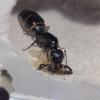A common problem for antkeepers are ants that won't move out of a dirty test tube. Often our motivations for wanting a colony to move are more selfish than altruistic. The test tube is dirty or the glass is cloudy and we can't see our pets. But sometimes it can feel like ants just won't move even when it seems to be to their advantage.
The most common advice to encourage ants to move is to expose the old nest to light while making the new nest dark. This can often work, but sometimes even light shy species such as Formica and Camponotus will stubbornly stay in a brightly lit nest ignoring the clean dark new formicarium. This can put a colony in danger since exposing a queen to light may make her lay fewer eggs, and probably causes more stress shortening her life.
I've read about antkeepers who kept their poor ants in light for days even as they refused to move.
There is an alternative that I've found to almost always be more effective: Heat and cold.
Ironically by shining a light on a nest it may seem more appealing rather than less due to a slight difference in heat. Ants can sense microclimates, and even a half degree difference matters to them.
I've been trying to get a colony of F. subsericea to move into a hydrated nest. I decided to skip the bright lights and avoid stressing the queen. This morning I discovered they had unexpectedly moved! What had changed? Well it was a very cold morning in NYC and our building didn't turn on the heat. I made myself a hot cup of tea and shivered as I check on the ants. The test tube they moved to was a little closer to the heat cable for another colony. The heat cable is about six inches away. The difference between their old tube and the new one is literally ONE DEGREE F. I check with an infrared heat sensor!
(I don't like to put heat cables on test tubes since it's hard to make a heat gradient.)
I think the cold weather and the temp drop in our apartment ( it was maybe 65F ) made that extra degree (66F) matter more. I've move the heat cable so it's a little closer to them (about an inch away) and they seem to love it. The tube is now 76F and that seems safe. Other parts of the outworld and nest are closer to 68F, so even if it gets warmer they will have places to move should they get too hot.
I have also had good results using ice packs to force ants out of nest in "emergencies" (I had a problem with Pogonomyrmex a few years back chewing a hole in a plaster nest so they simply could not be trusted to stay in that nest any more. I needed them to move right away. I tried light... it did nothing. I tried gently heating the new nest and that did a little. Then I put an ice pack wrapped in a wash cloth on their old nest and that got them out. It was harsh, but I just couldn't leave them in there when I was at work...)
What methods do you find most effective to get ants to move? Have you developed any tricks?

















